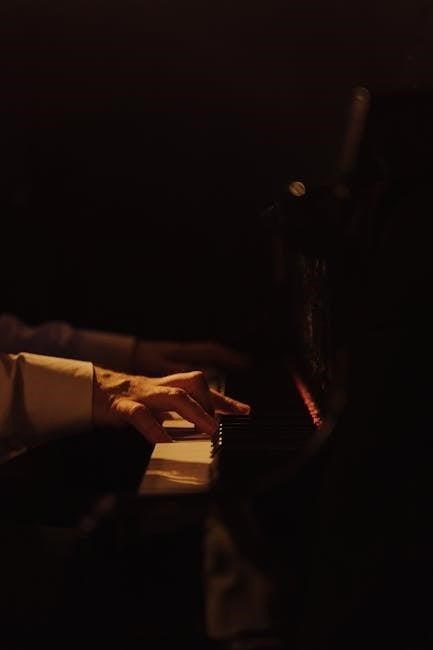Article Plan: Canon in D Piano Sheet Music PDF
Johann Pachelbel’s Canon in D is a timeless piece, frequently sought after by pianists. This guide explores where to find free PDF sheet music, catering to varying skill levels. We’ll delve into arrangements, structure, and even creating your own version.
Johann Pachelbel’s Canon in D is a cornerstone of classical music, instantly recognizable and deeply cherished. Its enduring appeal stems from its simple yet elegant structure. The piece showcases a repeating bass line (ostinato) over which three violins play a melody in canon, creating a rich, layered texture that is easily adaptable to piano arrangements for players of all skills. Many seek free piano sheet music to enjoy its beauty.
The Popularity and Enduring Appeal
Pachelbel’s Canon in D maintains immense popularity due to its soothing melody and adaptable structure. This section will explore its history and the reasons behind its lasting appeal across generations, examining why it continues to resonate with audiences.
Brief history and context of Canon in D.
Composed around 1680, Pachelbel’s Canon in D was initially part of a larger work, “Canon and Gigue in D major.” Despite its Baroque origins, it remained relatively obscure until the 20th century. Its rediscovery led to widespread use in weddings, film scores, and popular culture, cementing its place as a beloved classical piece.
Reasons for its continued popularity.
The Canon’s popularity stems from its simple yet elegant structure, built upon a repeating bass line. This structure allows for easy memorization and improvisation. Its soothing, harmonious melodies evoke feelings of peace and joy, making it ideal for celebratory occasions and reflective listening. Furthermore, its adaptability to various instruments enhances its reach.
Finding Free Canon in D Piano Sheet Music
Numerous online resources offer free Canon in D piano sheet music. These platforms provide access to various arrangements, from beginner-friendly versions to more complex interpretations, readily available for download and printing.
Online resources for free sheet music.
Several websites offer free PDF downloads of Canon in D piano sheet music. These often include arrangements for different skill levels; IMSLP (International Music Score Library Project) is a popular resource for public domain scores. Other sites may offer simplified versions or arrangements. Always check the source for copyright information before downloading. Many sites offer midi files as well. These can be useful for playback and learning. Be sure to explore various websites and find a version that matches your skill level and preferences.
IMSLP (International Music Score Library Project).
IMSLP, or the International Music Score Library Project, is a valuable resource for finding public domain sheet music. It houses a vast collection of scores, including various arrangements of Pachelbel’s Canon in D for piano. You can find versions for solo piano, as well as arrangements for piano with other instruments. Be sure to browse the different arrangements and editions available to find one that suits your needs. IMSLP is a completely legal resource, as all the music hosted is in the public domain.
Different Arrangements and Skill Levels
The Canon in D’s enduring appeal lies in its adaptability. Numerous arrangements exist for various skill levels, from beginner-friendly versions to more complex, advanced interpretations. Explore these diverse options to find the perfect fit for your piano proficiency.
Easy piano arrangements for beginners.
For novice pianists, simplified arrangements of Pachelbel’s Canon in D offer an accessible entry point. These versions often focus on the melody and basic harmony, omitting complex embellishments. Look for sheet music specifically labeled “easy piano” or “beginner arrangement.” Some arrangements are even designed for small hands, making the piece more comfortable to play. These versions allow beginners to experience the beauty of the Canon while developing fundamental piano skills.
Intermediate and advanced arrangements.
Pianists seeking a greater challenge will find numerous intermediate and advanced arrangements of Canon in D. These versions incorporate more complex harmonies, intricate ornamentation, and varied rhythmic patterns. Some arrangements may include the original Canon and Gigue in D major, offering a fuller musical experience. These versions often require a higher level of technical skill and musical understanding, providing a rewarding experience for experienced pianists seeking to master this iconic piece.
Understanding the Canon in D Structure
To truly appreciate Canon in D, understanding its structure is essential. This section will dissect the piece, focusing on the underlying bass ostinato and the ingenious canonic melody that intertwine to create its enchanting effect.
The bass ostinato.
The Canon in D’s foundation rests upon a repeating bass line, known as the ostinato. This simple, yet effective, sequence typically consists of eight chords in D major. The bass ostinato provides a harmonic structure over which the canonic melodies unfold. Its repetitive nature creates a sense of stability and predictability, allowing the listener to focus on the evolving melodic layers above. Understanding the bass line is key to grasping the piece’s overall harmonic progression and appeal.
The canonic melody.
Above the steady bass ostinato, the Canon in D features a melody played in canon. This means the melody is introduced by one voice, then imitated by subsequent voices at set intervals. These melodic lines intertwine, creating rich harmonies and a sense of continuous development. The canonic structure is a key element of the piece’s beauty and complexity. As each voice enters, it adds another layer to the musical texture, creating a captivating listening experience.

Printing and Using PDF Sheet Music
Once you’ve found your Canon in D sheet music PDF, printing it correctly is vital. We’ll cover ensuring clear print quality and offer tips for effectively reading and playing directly from the printed sheet music.
Ensuring proper printing quality.
To guarantee the best playing experience, focus on printing quality. Select high resolution in your printer settings. Use good quality paper to prevent ink bleed. Check the printed sheet for any smudges or faded areas. If necessary, adjust the contrast settings before printing again. A clear print ensures effortless reading of the notes. Doing this will help to avoid possible mistakes and to make sure you are performing the song properly.
Tips for reading and playing from sheet music.
Start by identifying the key signature and time signature to understand the musical context. Practice reading each hand separately before combining them. Pay attention to dynamic markings and tempo indications. Use a pencil to mark fingerings and other helpful notes. Break down complex passages into smaller, manageable sections. Regularly practice sight-reading to improve your fluency. With patience and practice, you can confidently play the Canon in D with accurate expression and interpretation. This will help with playing the song.
Copyright and Legal Considerations
Before downloading and distributing sheet music, understanding copyright is crucial. We’ll examine the public domain status of Canon in D and guide you to legitimate sources for sheet music downloads. This ensures you’re accessing music legally and ethically.
Understanding public domain status.
Determining whether Canon in D sheet music is in the public domain is key for legal use. Generally, works enter the public domain after a certain period following the composer’s death, varying by country. However, specific arrangements might have separate copyrights. Always verify the copyright status before distributing, performing, or adapting any sheet music to avoid infringement. Resources like the IMSLP often indicate copyright information, helping users make informed decisions about usage.
Legitimate sources for sheet music downloads.
When seeking Canon in D piano sheet music PDFs, prioritizing legitimate sources is crucial. Reputable websites like IMSLP (International Music Score Library Project) offer a vast collection of public domain scores. Paid platforms like Musicnotes provide licensed arrangements, ensuring fair compensation to arrangers. Always be wary of unofficial sites promising free downloads, as they may infringe on copyright or contain inaccurate transcriptions. Supporting legitimate sources ensures continued access to high-quality sheet music and respects creators’ rights.

Learning Resources and Tutorials
Numerous online resources exist for learning Canon in D on piano. These include video tutorials, interactive lessons, and method books designed for various skill levels, aiding in mastering this beautiful piece.
Online piano lessons and tutorials.
The internet is abundant with resources to learn Canon in D. Platforms like YouTube offer free tutorials breaking down the piece into manageable sections. Websites dedicated to piano lessons often feature courses tailored to different skill levels, providing step-by-step guidance. These resources can greatly assist in understanding the nuances and techniques required to play Canon in D effectively, making learning accessible and enjoyable.
Method books and educational materials.
Supplementing online resources, method books offer structured learning paths. Series like Bastien and Alfred provide progressive exercises, building foundational piano skills while incorporating familiar tunes like Canon in D. These books often include music theory explanations, helping players understand the underlying principles. For a deeper dive, explore books focusing on Baroque music or specific techniques used in Canon in D, enhancing your overall musical understanding.

Arranging Your Own Version
Creating a personal arrangement of Canon in D allows for unique expression. Experiment with different voicings, rhythms, and harmonies. Notation software like MuseScore can aid in transcribing and refining your arrangement, bringing your creative vision to life.
Tips for creating a personal arrangement.
When arranging your own version of Canon in D, consider the overall mood and style you want to achieve. Experiment with different time signatures or rhythmic variations to add a unique flavor. Explore adding counter-melodies or embellishments to the original canonic lines. Don’t be afraid to alter the harmony slightly, perhaps by adding seventh chords or inversions. Remember to keep the essence of the Canon intact while injecting your own creative voice and style.
Using music notation software.
Music notation software like MuseScore Studio simplifies the process of creating and editing your Canon in D arrangement. These programs allow you to input notes, chords, and other musical elements with ease, offering tools for playback and printing. Features such as transposition, part extraction, and customizable layouts enhance your workflow. Experiment with different notation styles and fonts to personalize your score. Remember to save your work frequently and utilize the software’s help resources.

Canon in D in Popular Culture
Canon in D enjoys widespread use in various cultural contexts. Its presence extends from weddings, symbolizing unity, to its appearance in numerous films and television shows, adding emotional depth and timeless elegance to scenes.
Use in weddings and other events.
Pachelbel’s Canon in D is a staple at weddings, often played during processional or recessional moments. Its gentle and flowing melody creates a romantic and elegant atmosphere, perfectly complementing the joyous occasion. The Canon’s enduring popularity makes it a versatile choice for various events beyond weddings, including anniversaries, receptions, and even memorial services, offering a sense of peace and reflection through its musical beauty. Its adaptability ensures it resonates with diverse audiences and settings.
Appearances in film and television.
Canon in D’s widespread recognition extends to film and television, where it’s frequently used to evoke emotions ranging from romance to solemnity. Its presence in soundtracks often signifies a poignant moment, a nostalgic reflection, or a developing relationship; The piece’s familiarity allows filmmakers to quickly establish a mood or underscore a scene’s emotional depth. From romantic comedies to dramas, Canon in D’s adaptable nature makes it a valuable tool for cinematic storytelling, enhancing the viewing experience through its universally recognized melody.
Other Instruments and Ensembles
Beyond the piano, Canon in D lends itself beautifully to various instruments and ensembles. Adaptations for violin, guitar, and even full orchestras exist. These arrangements showcase the piece’s versatility and enduring appeal across different musical contexts.
Arrangements for violin and piano.
Canon in D arrangements for violin and piano are incredibly popular, offering a beautiful duet opportunity. The violin often carries the melodic line, while the piano provides harmonic support with the famous bass ostinato. Free sheet music for these arrangements can be found online, often categorized by skill level. These versions capture the essence of Pachelbel’s masterpiece in a new instrumental combination, enriching its timeless appeal and accessibility.
Adaptations for other instruments.
Beyond piano and violin, Canon in D lends itself beautifully to adaptations for various instruments. Flute, guitar, cello, and even orchestral arrangements are readily available. These adaptations often retain the core harmonic progression and melodic structure, adapting it to the instrument’s unique capabilities. Free sheet music for these diverse arrangements can be sourced online, allowing musicians of all backgrounds to enjoy and perform Pachelbel’s enduring work in creative and personalized ways.
Pachelbel’s Canon in D remains a captivating and beloved piece of music, transcending generations with its simple yet profound beauty. Its enduring popularity stems from its elegant structure and emotional depth, making it a favorite for weddings, film scores, and personal enjoyment. With readily available piano sheet music in PDF format, musicians of all levels can explore and appreciate the timeless appeal of this classical masterpiece, ensuring its legacy continues to resonate for years to come.
